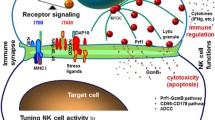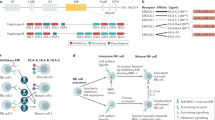Abstract
Natural killer (NK) cells are a subset of lymphocytes with a distinct morphologic appearance (large granular lymphocytes [LGL]) and the ability to kill virally infected and tumor targets but to spare most normal cells. NK cells respond to a variety of biologic agents, such as interleukin-2 (IL-2), or interferons, by upregulation of cytolytic, secretory, and proliferative functions. In cancer-bearing hosts, NK cells have been considered to be the major component of antitumor immunity responsible for rapid elimination of malignant cells from the blood. More recently, however, studies have demonstrated the ability of adoptively transferred, IL-2-activated NK cells to selectively localize into solid tumors tissue and to eliminate established tumors. While these findings indicate a role for NK cells in cancer immunotherapy, additional studies are needed in both animal models and in humans to optimize clinical protocols of cancer therapy based on these cells.
Similar content being viewed by others
References
Whiteside, T. L., Vujanovic, N. L., and Herberman, R. B. (1997) Natural killer cells and tumor therapy, in Current Topics in Microbiology and Immunology 230 (Karre, K. and Colonna, M., eds.), Springer, Heidelberg, Germany, pp. 221–244.
Kim, S., Iizuka, K., Aguila, H. L., Weissman, I. L., and Yokoyama, W. M. (2000) In vivo natural killer cell activities revealed by natural killer cell-deficient mice. Proc. Natl. Acad. Sci. USA 97, 2731–2736.
Vujanovic, N. L., Nagashima, S., Herberman, R. B., and Whiteside, T. L. (1996) Nonsecretory apoptotic killing by human NK cells. J. Immunol. 157, 1117–1126.
Schwarz, R. E., Vujanovic, N. L., and Hiserodt, J. C. (1989) Enhanced antimetastic activity of lymphokine-activated killer cells purified and expanded by their adherence to plastic. Cancer Res. 49, 1441–1446.
Vujanovic, N. L., Rabinowich, H., Lee, Y. J., Jost, L., Herberman, R. B., and Whiteside, T. L. (1993) Characteristics of human natural killer cells obtained by rapid interleukin 2-induced adherence to plastic. Cell Immunol. 151, 133–157.
Lister, J., Ryoka, W. B., Donnenberg, A. D., et al. (1995) Autologous peripheral blood stem cell transplantation and adoptive immunotherapy with A-NK cells in the immediate post-transplant period. Clin Cancer Res. 1, 607–614.
Yasumura, S., Lin, W-c., Hirabayashi, H., Vujanovic, N. L., Herberman, R. B., and Whiteside, T. L. (1994) Immunotherapy of liver metastases of human gastric carcinoma with IL-2 activated natural killer cells. Cancer Res. 54, 3808–3816.
Basse, P., Herberman, R. B., Nannmark, U., Johansson, E. R., Hokland, M., Wasserman, K., and Goldfarb, R. (1991) Accumulation of adoptively transferred A-LAK cells in metastases. J. Exp. Med. 174, 479–488.
Whiteside, T. L. (1997) Isolation of human NK cells and generation of LAK activity, in Current Protocols in Immunology (Coligan, J. E., Kruisbeek, A. M., Margulies, D. H., Shevack, E. M., and Warren, S., eds.), Wiley, vol. 2, unit 7. 7.
Gunji, Y., Vujanovic, N. L., Hiserodt, J. C., Herberman, R. B., and Gorelik, E. (1989) Generation and characterization of purified adherent lymphokine-activated killer cells in mice. Immunol. 142, 1748–1754.
Whiteside, T. L. (1997) Measurement of cytotoxic activity of NK/LAK cells, in Current Protocols in Immunology (Coligan, J. E., Kruisbeek, A. M., Margulies, D. H., Shevack, E. M., and Warren, S., eds.), Wiley, vol. 2, unit 7. 18.
Okada, K., Nannmark, U., Vujanovic, N. L., Watkins, S., Basse, P., Herberman, R. B., and Whiteside, T. L. (1996) Elimination of established liver metastasis by human interleukin 2-activated natural killer cells after locoregional or systemic adoptive transfer. Cancer Res. 56, 1599–1608.
Basse, P. H., Herberman, R. B., Hokland, M. E., and Goldfarb, R. H. (1992) Tissue Distribution of Adoptively Transferred Adherent Lymphokine-Activated Killer Cells: Role of Route of Administration. Natl. Immunity and Cell Growth Reg. 11, 193–202.
Basse, P., Hokland, P., Heron, I., and Hokland, M. (1988) Fate of left ventricular injected cancer cells in Balb/c mice: role of NK cells. JNCI. 80, 657–665.
Nannmark, U., Johansson, B. R., Bryant, J. L., Unger, M. L., Hokland, M. E., Goldfarb, R. H., and Basse, P. (1995) Microvessel origin and distribution in pulmonary metastases of B16 melanoma: implication for adoptive immunotherapy. Cancer Res. 55, 4627–4632.
Dethlefsen, L. A., Prewitt, J. M. S., and Mendelson, M. L. (1968) Analysis of tumor growth curves. JNCI. 40, 389–405.
Melder, R. J., Walker, E., Herberman, R. B., and Whiteside, T. L. (1991) Adhesion characteristics of human interleukin-2-activated natural killer cells. Cellular Immunol. 132, 17–192.
Author information
Authors and Affiliations
Corresponding author
Rights and permissions
About this article
Cite this article
Basse, P.H., Whiteside, T.L. & Herberman, R.B. Cancer immunotherapy with interleukin-2-activated natural killer cells. Mol Biotechnol 21, 161–170 (2002). https://doi.org/10.1385/MB:21:2:161
Issue Date:
DOI: https://doi.org/10.1385/MB:21:2:161




